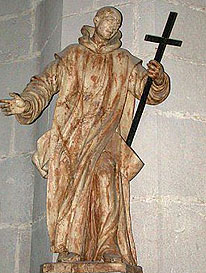
 Who We Are
Who We Are
 Our Guidelines
Our Guidelines
 Customs
Customs
 Membership
Membership
 Patron Saints
Patron Saints
 Photo Album
Photo Album
 Links
Links
 Contact us
Contact us
 Home
Home
St. Bruno
| Date | Event |
|---|---|
| 1030 | Born in Cologne, Germany. |
| 1044 | Becomes student in Rheims (France) at the school/university attached to the beautiful cathedral there. Upon finishing his studies, becomes a teacher and scholar, especially of Scriptures. Also becomes a canon of the Cathedral and lives there with other canons under a religious rule attached to the Cathedral. |
| 1058 | Appointed as Rector, or head, of the school. |
| 1073 | Manasses becomes Archbishop of Rheims and great controversy soon starts over his possible simonical purchase of that position. |
| 1076 | Bruno appointed as Chancellor of the Archdiocese under Archbishop Manasses while continuing as Rector of the School. |
| 1077 | Bruno, along with several other canons of the Cathedral, is forced to take refuge from Archbishop Manasses and goes into exile at castle of Count Ebal of Roucy. |
| 1080 | Manasses is finally deposed as Archbishop and Bruno returns to Cathedral school. Popular acclaim for Bruno to be appointed as Archbishop of Rheims, but he declines. Soon decides with two others, including Raoul le Verd, to "flee the world" and enter the monastic life. |
| 1081 | Bruno leaves Rheims and, with two companions (not the two mentioned above), begins a form of semi-eremitical life in the woods 5 miles from the Abbey of Molemes (St. Robert - Abbot) at Sech-Fontaine (Dry-Fountain). |
| 1084 | Leaves Sech-Fontaines (probably alone) and travels to Grenoble (France). With 6 other new companions, goes to Bishop Hugh, who, on June 24, 1084, establishes the seven monks, under Bruno′s leadership, in the mountains near Grenoble at the Grande Chartreuse. |
| 1090 | The new Pope, Urban II (Bruno′s former pupil at Rheims), calls Bruno to Rome to assist the Pope with his counsel in the continuing church crisis over simony and lay-investiture. Crisis occurs at Grande Chartreuse over Bruno′s leaving: the other monks leave Grande Chartreuse, but return upon Bruno′s pleadings for them to return. Pope and Papal Court are forced to flee to southern Italy. Pope nominates Bruno as Archbishop of Reggio de Calabria, but Bruno does not want this. |
| 1091 | Pope allows Bruno to leave Papal Court, seeing his true call to the monastic life, but wants to keep him nearby for the future. Bruno establishes a second monastery in Calabria (southern Italy) at St. Mary of La Torre with some companions. |
| 1096-1101 | While at St. Mary of La Torre, Bruno writes letter to Raoul le Verd. |
| 1099-1100 | Landuino, Prior of the Grande Chartreuse, visits Bruno at St. Mary of La Torre. Bruno writes letter to his monastic brethren at the Grande Chartreuse and gives it to Landuino. |
| October 6, 1101 | Bruno dies at St. Mary of La Torre. |
What I admire about Bruno
Bruno′s life portrays, to me, the absolute dedication to seek God alone in the monastic vocation. He was also a pioneer, developing a new form of monasticism in the West.
He seemed to strive for a real purity of monastic life and showed his devotion to this life by twice refusing calls to the active life as an Archbishop.
I also admire Bruno′s learning and scholarship, yet it was combined with great humility.
Bruno also suffered some real trials in his life, yet God worked things out for him to fulfill his true vocation.
Trials Bruno suffered
Two great ones were:
- his persecution and time of exile under Archbishop Manassas, and
- the real cross in having to leave the Grande Chartreuse under obedience to the Pope and risk the failure of his monastic foundation at the Grande Chartreuse. Yet, God brought Bruno through both of these trials and even strengthened his calling to the monastic life through them!
Barry Burrus